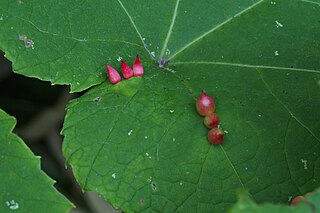
Asphondylia is a cosmopolitan genus of gall midges in the family Cecidomyiidae. All species in this genus induce galls on plants, especially on flowers and flower buds. There are over 300 described species in Asphondylia, with many more likely to be discovered and described, especially in the southern hemisphere.

Rhopalomyia is a genus of gall midges, insects in the family Cecidomyiidae. There are at least 267 described species in Rhopalomyia. Most species in this genus induce galls on plants in the Asteraceae. This genus has a cosmopolitan distribution. Rhopalomyia was first established by Ewald Heinrich Rübsaamen in 1892.
Catotricha is a genus of midges in the family Cecidomyiidae. The five described species in Catotricha are found in the holarctic region. This genus was established by British entomologist Frederick Wallace Edwards in 1938.
Catotrichinae is a subfamily of Cecidomyiidae. Members of this subfamily were formerly included in Lestremiinae and are considered the most primitive members Cecidomyiidae. The larvae feed on fungi. Five genera are currently recognized.

Ampelomyia vitiscoryloides, the grape filbert gall midge, is a species of gall midge in the family Cecidomyiidae. It induces galls on grape plants and is widespread in eastern North America. It was first described by Alpheus Spring Packard in 1869.
Amedia is a genus of wood midges in the family Cecidomyiidae. The only described species - Amedia floridana - is only known from Florida. The genus was established by Mathias Jaschhof in 1997.
Aprionus is a genus of wood midges in the family Cecidomyiidae. There are at least 137 described species in Aprionus. The genus was established by Jean-Jacques Kieffer in 1894.

Ampelomyia vitispomum is a species of gall midge in the family Cecidomyiidae. It induces galls on grape plants in eastern North America. It was first described by Carl Robert Osten-Sacken in 1878.
Ampelomyia is a genus of gall midges in the tribe Asphondyliini. It consists of the following four species, all of which form galls on grape plants:
Anabremia is a genus of gall midge in the family Cecidomyiidae. The six described species are found in the Palearctic and likely inquilines of Dasineura galls on plants in the legume family. This genus was first described by Jean-Jacques Kieffer in 1912.
Massalongia is a genus of flies in the family Cecidomyiidae. The larvae induce galls on birches.
Wheeleriola is a genus of midges in the family Cecidomyiidae. The one described species in this genus - Wheeleriola perplexa - is known only from New Zealand.
Mesotrichoca is a genus of midges in the family Cecidomyiidae. The one described species in the genus - Mesotrichoca mesozoica - is known only from Siberia from a sediment fossil associated with the Late Jurassic and Lower Cretaceous epochs. This species was placed in Catotricha when it was first described by Russian entomologist Vladimir Grigoryevich Kovalev. This genus was established by Mathias Jaschhof and Catrin Jaschhof in 2008.
Anodontoceras is a genus of wood midges in the family Cecidomyiidae. There are three described species. The genus was established by Japanese entomologist Junichi Yukawa in 1967.
Ansifera is a genus of midges in the family Cecidomyiidae. The five described species are found in the Palearctic and Oriental regions. The genus was first described by Mathias Jaschhof in 2009.
Antennardia is a genus of midges in the family Cecidomyiidae. The four described species are found in the Holarctic realm. The genus was first described by Boris Mamaev in 1993, but was subsequently treated as a subgenus of Monardia until being reinstated at the genus level.
Berestella is a genus of wood midges in the family Cecidomyiidae. The only described species - Berestella insuperabilis - is only known from Rovno amber from the Late Eocene. The genus was established in 2007 and named for Ukrainian entomologist Zoya L. Berest.
Corporesana is a genus of wood midges in the family Cecidomyiidae. The one described species - Corporesana khatanga - is only known from Taymyr amber from the Late Cretaceous.
Gagnea is a genus of wood midges, insects in the family Cecidomyiidae. The one described species - Gagnea tsutaensis - is known only from Japan. The genus was established by Mathias Jaschhof in 2001 and named after American entomologist Raymond Gagné.

Ampelomyia conicocoricis is a species of fly in the family Cecidomyiidae. It induces galls on grape plants in Japan. This is the type species for the genus.




